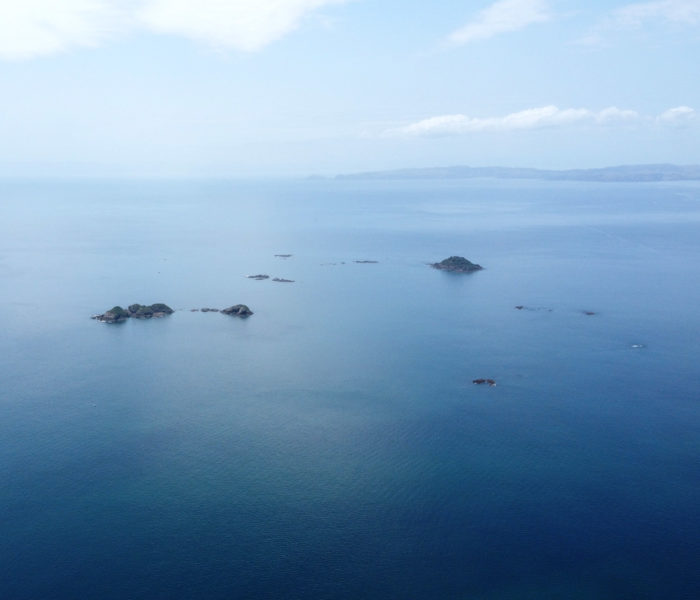The Noises lie in the outer bounds of the inner Hauraki Gulf Marine Park / Tīkapa Moana / Te Moananui-ā-Toi, approximately 24km north-east of Auckland and 2.2km from Rakino, their closest neighbour.
The Noises are a chain of islands and rock stacks all composed of 130 million-year-old Jurassic greywacke rocks of marine origin, which in the Auckland region run northwards from the Hunua Ranges through Waiheke and the inner Gulf islands to Kawau, Tawharanui and Cape Rodney.
Cranwell 1981, Ballance 1993
There are four main islands in the group – Ōtata, Motuhoropapa, Maria/Ruapuke and the David Rocks – all of which are predator free. The remainder of The Noises is made up of the smaller islands of Orarapa (Haystack), Ike, Scott and Sunday, numerous rocky outcrops (like Tern rock) and numerous rocky reefs (Takapu, Zeno and the Ahaaha’s).
The Noises have outstanding conversation values (Cameron 1998) and contain some of the best indigenous vegetation of all of the inner Hauraki Gulf Islands. The islands are now home to a range of invertebrates and reptiles – including gecko and wetapunga – providing source populations for translocations to other locations.
The islands are a regionally important breeding site for seabirds including takahikare/white-faced storm petrel, oi/grey-faced petrel, kuaka/northern diving petrel, pakaha/fluttering shearwater, korora/little blue penguin, tara/white-fronted tern, tarapunga/red-billed gull, kawau paka/little shag and the karuhiruhi/pied shag. On land, native bird species include tui, bellbird, kakariki, grey warbler, morepork and variable oyster catcher. There are at least 15 Nationally Threatened and At-Risk bird species recorded on the islands or from the sea around the islands (Department of Conservation 2014).
Theories around the origin of the name The Noises vary. One theory is that the noise of the bird life may have influenced the name. Another is that French Explorer, Durmont D’Urville who came across a scattering of rocky islets just to the east of Rakino Island in early 1827 called them Les Noisettes (which translates to “The Hazelnuts”).
Mana whenua have been known to refer to the islands as the “net floats” of Nga Poitu o Taramainuku.

The Noises. Photo: Joseph Neureuter.
History
Mana whenua occupied and utilised these islands from ancient times. Archaeological evidence gathered from The Noises supports the oral histories of human presence from times prior to and after the eruptions of Rangitoto through to modern times.
There is a complex weave of Mana whenua interests in Tīkapa Moana/Hauraki Gulf and the area around The Noises. Native Land Court records from 1866 and 1867 show that Ngati Tai / Ngai Tai and Ngati Paoa claims to the islands were recognised at that time. The court hearing records also contain important and pertinent historic information that is relevant today.
It is understood that the high costs associated with the court hearing were the cause of the subsequent sale of The Noises – an unfortunate position that many mana whenua were circumstantially forced into with their land throughout Aotearoa at the time.
The first land registration records therefore date back to 1868.
The islands were then sold again in 1874 to Mr Aitken for £28 and passed through various owners over the years, including JJ Craig from 1907 (a merchant/quarryman) who built a small house/bach on Ōtata Island, and Captain McKenzie who purchased the islands in 1930.
In 1933, Captain Frederick Wainhouse, a retired master mariner who had worked for the Auckland Harbour Board, purchased the islands for £200.
Shortly thereafter, Wainhouse married Margaret Neureuter and the couple lived there permanently in the bach on Ōtata Island after the Second World War. They established fruit trees and large vegetable gardens on Ōtata Island and kept chickens. The abundant sea around them was integral to supporting a balanced diet. There was no power, refrigeration or telecommunications.
Wainhouse’s nephew, Brian Neureuter, ran a boat on the Auckland Harbour and regularly took supplies out to his uncle and aunt.
After Captain Wainhouse died on Ōtata in 1957, the ownership was briefly held by his wife Margaret Wainhouse (nee Neureuter) who passed the islands on to her nephew, Brian.
In 1995, the Noises Trust was formed by the Neureuter family and the islands were gifted to the Trust. The Trust was created to help ensure the long-term protection of the island group.
The Neureuter family aspire to enabling continued research and education on and around The Noises, and for The Noises to become a model that will inspire further conservation work. Mana whenua, including descendants of claimants from the 1866/1867 hearings are now involved in the various projects around the islands alongside the Neureuter family.
